In accordance with Safe Drinking Water regulations the Commission routinely monitors for the presence of drinking water contaminants including the disinfection byproducts (DBPs) haloacetic acids (HAA5) and total trihalomethanes (TTHM).
DBPs form when dissolved natural organic matter (NOM) interacts with chlorine. Extreme weather patterns can impact raw water quality, and data indicates that the more intense precipitation patterns in recent years are increasing the amount of NOM in Cobble Mountain Reservoir. The Commission’s West Parish Filters Water Treatment Plant, last modernized in the 1970s, is not capable of removing the amount of NOM now necessary to consistently meet the DBP regulations.
More information on DBPs, how they get into the water, and what the Commission is doing to address the problem is available on the DBP Frequently Asked Questions page.
Below is a quarterly update on disinfection byproduct sampling and factors impacting DBP levels in the finished drinking water.
2025
Public notification issued for an exceedance of the maximum contaminant level (MCL) for HAA5 based on sample results from June 3, 2025.
Q2-2025 DBP Status Report:
The amount and types of NOM in Cobble Mountain Reservoir continue to fluctuate based on weather patterns and other conditions in the reservoir, such as annual reservoir turnover. As NOM levels fluctuate, DBPs still form due to the amount and types of NOM in the raw water and necessary chlorine dosages to maintain safe disinfection.
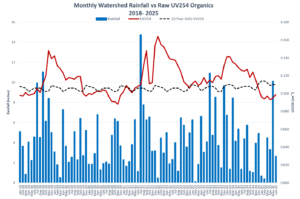
Public notification issued for an exceedance of the maximum contaminant level (MCL) for HAA5 based on sample results from March 4, 2025.
Q1-2025 DBP Status Report:
The amount and types of NOM in Cobble Mountain Reservoir fluctuated throughout 2024 and in the fall returned to more typical levels based on the 10-year average. In early 2025 the organic levels were below the 10-year average, but continue to fluctuate.
Quarterly sampling in March 2025 showed all sample locations below 60 ppb. Since the annual average at 3 of the 8 sample sites exceeded 60 ppb, however, the results still qualify as an exceedance of the MCL.
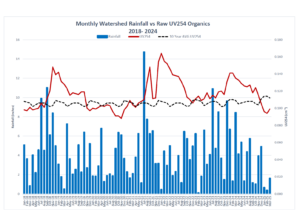
Data shows that high amounts of precipitation are followed by spikes in the amount of natural organic matter (measured by UV254) in Cobble Mountain Reservoir. In fall 2024 NOM levels were down from more elevated levels in winter (December 2024-February 2024). In early 2025 NOM levels remained below the 10-year average but continue to fluctuate.
2024
Public notification issued for an exceedance of the maximum contaminant level (MCL) for HAA5 based on sample results from December 3, 2024.
Q4-2024 DBP Status Report:
The amount and types of NOM in Cobble Mountain Reservoir fluctuated throughout 2024 based on a variety of weather events. Data from December 2024 shows organics returning to more typical levels based on the 10-year average. However, it should be noted that samples for Q4 were taken in early in the month, on December 3, and more elevated NOM levels indicated in November 2024 data may have contributed to elevated DBPs.
Additionally, the regulatory limit for DBPs is a running annual average, and elevated results from past quarters may also impact compliance calculations.
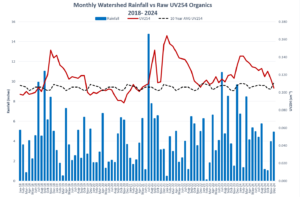
Data shows that high amounts of precipitation and severe weather events are followed by spikes in the amount of natural organic matter (measured by UV254) in Cobble Mountain Reservoir
Public notification issued for an exceedance of the maximum contaminant level (MCL) for HAA5 based on sample results from September 3, 2024.
Q3-2024 DBP Status Report:
Weather patterns and storm events continue to impact the amount and types of NOM in Cobble Mountain Reservoir. Water quality and weather data indicates that precipitation events are often followed by spikes in organic material in the reservoir.
Additionally, the regulatory limit for DBPs is a running annual average, and elevated results from past quarters may also impact compliance calculations.
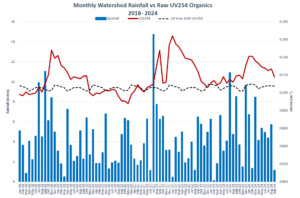
Data shows that high amounts of precipitation are followed by spikes in the amount of natural organic matter (measured by UV254) in Cobble Mountain Reservoir. In October 2024 NOM levels were down from more elevated levels in winter (December 2024-February 2024). But rain events in the spring and summer contributed to NOM levels remaining above average (the gray dotted line shows the 10-year average).
Public notification issued for an exceedance of the maximum contaminant level (MCL) for HAA5 based on sample results from June 4, 2024.
Q2-2024 DBP Status Report:
Weather patterns and severe storm events continue to impact the amount and types of NOM in Cobble Mountain Reservoir.
Rainfall, particularly intense and severe storms can impact NOM levels in the reservoir. Raw water quality can also be impacted by annual reservoir turnover, during which the top layer of water shifts to the bottom of the reservoir. Annual reservoir turnover occurred in fall 2023. The regulatory limit for DBPs is a running annual average, and elevated results from past quarters may also impact compliance calculations.
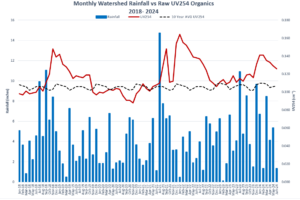
Data shows that high amounts of precipitation are followed by spikes in the amount of natural organic matter (measured by UV254) in Cobble Mountain Reservoir.
Public notification issued for an exceedance of the maximum contaminant level (MCL) for HAA5 based on sample results from March 5, 2024.
Q1-2024 DBP Status Report:
Weather patterns and severe storm events continue to impact the amount and types of NOM in Cobble Mountain Reservoir. Higher than average rainfall in summer 2023 caused NOM levels in the reservoir to increase and continue to impact reservoir water quality into 2024.
Raw water quality can also be impacted by annual reservoir turnover, during which the top layer of water shifts to the bottom of the reservoir. Annual reservoir turnover occurred in fall 2023.
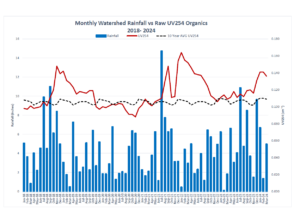
Data shows that high amounts of precipitation are followed by spikes in the amount of natural organic matter (measured by UV254) in Cobble Mountain Reservoir. NOM levels in the reservoir remained at more average levels early in 2023 (the gray dotted line shows the 10-year average) but intense rain events throughout the year, and annual reservoir turnover in fall 2023 impacted raw quality and UV254 levels.
2023
Public notification issued for an exceedance of the maximum contaminant level (MCL) for HAA5 based on sample results from December 5, 2023.
Q4-2023 DBP Status Report:
Weather patterns and severe storm events continue to impact the amount and types of NOM in Cobble Mountain Reservoir. Higher than average rainfall in summer 2023 caused NOM levels in the reservoir to increase after returning to more normal levels earlier in 2023.
Raw water quality can also be impacted by annual reservoir turnover, during which the top layer of water shifts to the bottom of the reservoir. Annual reservoir turnover occurred in fall 2023.
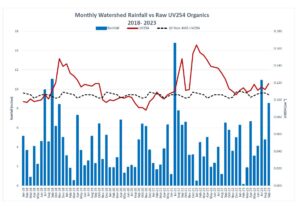
Data shows that high amounts of precipitation are followed by spikes in the amount of natural organic matter (measured by UV254) in Cobble Mountain Reservoir. NOM levels in the reservoir remained at more average levels early in 2023 (the gray dotted line shows the 10-year average) but intense rain events throughout the year, and annual reservoir turnover in fall 2023 impacted raw quality and UV254 levels.
Public notification issued for an exceedance of the maximum contaminant level (MCL) for HAA5 based on sample results from September 5, 2023.
Q3-2023 DBP Status Report:
Weather patterns and severe storm events continue to impact the amount and types of NOM in Cobble Mountain Reservoir. Higher than average rainfall in July 2023 caused NOM levels in the reservoir to increase after returning to more normal levels earlier in 2023.
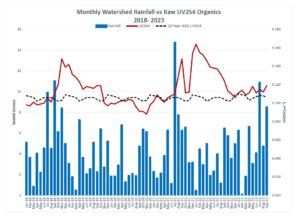
Data shows that high amounts of precipitation are followed by spikes in the amount of natural organic matter (measured by UV254) in Cobble Mountain Reservoir. NOM levels in the reservoir remain at more average levels in 2023 (the gray dotted line shows the 10-year average) but intense rain events in spring and summer 2023 did impact raw water quality and UV254 increased throughout the summer and into fall 2023.
Public notification issued for an exceedance of the maximum contaminant level (MCL) for HAA5 based on sample results from June 5, 2023.
Q2-2023 DBP Status Report:
Weather patterns and severe storm events continue to impact the amount and types of NOM in Cobble Mountain Reservoir. June sampling indicated that NOM levels in Cobble Mountain Reservoir remain at more typical levels after being unprecedently high following extreme weather in 2021.
The MCL for HAA5 is 60 parts per billion (ppb) calculated as the average of the results from the past four quarters at an individual sample site. All individual sample-site results from June 2023, were below the MCL of 60 ppb. Since the annual average at 5 of the 8 sample sites exceeded 60 ppb, however, the results still qualify as an exceedance of the MCL.
There was no exceedance of the MCL for TTHMs during June sampling.
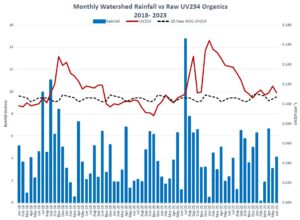
Data shows that high amounts of precipitation are followed by spikes in the amount of natural organic matter (measured by UV254) in Cobble Mountain Reservoir. Following record rainfall in 2021, which continued to impact raw water quality through 2022, NOM levels in the reservoir remain at more average levels in Q2 2023 (the gray dotted line shows the 10-year average) but is trending higher than average in June.
Public notification issued for an exceedance of the maximum contaminant level (MCL) for HAA5 based on sample results from March 1, 2023.
Q1-2023 DBP Status Report:
March sampling indicated that NOM levels in Cobble Mountain Reservoir continue to return to more normal levels after being unprecedently high following extreme weather in 2021.
The MCL for HAA5 is 60 parts per billion (ppb) calculated as the average of the results from the past four quarters at an individual sample site. All individual sample-site results from March 1, 2023, were below the MCL of 60 ppb. Since the annual average at 7 of the 8 sample sites exceeded 60 ppb, however, the results still qualify as an exceedance of the MCL.
There was no exceedance of the MCL for TTHMs during March sampling.
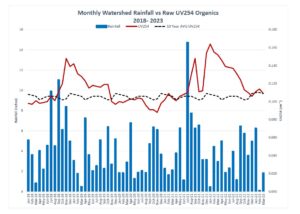
Data shows that high amounts of precipitation are followed by spikes in the amount of natural organic matter (measured by UV254) in Cobble Mountain Reservoir. Following record rainfall in 2021, which continued to impact raw water quality through 2022, NOM levels in the reservoir have returned to more average levels in Q1 2023 (the gray dotted line shows the 10-year average).
2022
Public notification issued for an exceedance of the maximum contaminant level (MCL) for HAA5 and TTHM based on sample results from December 1, 2022.
December 1, 2022 Sample Results
Q4-2022 DBP Status Report:
In fall 2022 NOM levels in Cobble Mountain Reservoir returned to more normal levels after being unprecedently high following extreme weather in 2021.While NOM levels in the reservoir were trending down, the Commission continued to report exceedances of the MCL for HAA5 and TTHM for Quarter 4. This was due in part by the utilization of older redundant slow sand filters, which are not as effective at removing NOM and contributed to the higher levels of DBPs in the distribution system. The slow sand filters were used in fall 2022 to meet demand as ongoing construction at West Parish Filters temporarily impacted the ability to maximize use of the rapid sand filters.
Additionally, because the MCL for HAA5 and TTHM are calculated as a Locational Running Annual Average (LRAA), previous, much more elevated DBP samples (particularly Quarter 1-2022) were factored into the LRAA.
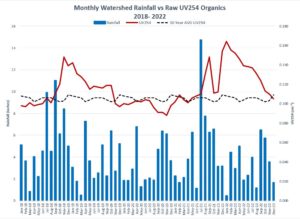
Data shows that high amounts of precipitation are followed by spikes in the amount of natural organic matter (measured by UV254) in Cobble Mountain Reservoir. Record rainfall in summer 2021 continued to impact water quality and DBP LRAA calculations through 2022.
Public notification issued for an exceedance of the maximum contaminant level for HAA5 and TTHM based on sample results from September 6, 2022.
September 6, 2022 Sample Results
Q3-2022 DBP Status Report:
In August 2022 repairs to one of the rapid sand filter beds was completed. With the filter repaired and back on-line the Commission is able to operate the rapid sand filters at full capacity and reduce reliance on the older slow sand filters, which are not as effective at removing NOM. The 1970s-era rapid sand filters remove more NOM than the slow sand filters but are not capable of removing the amount of NOM necessary to consistently meet DBP regulations which were first adopted in 1998 and updated in 2012.
Though NOM levels have somewhat decreased due to drier weather in summer 2022, NOM levels in the reservoir still remain elevated when compared to the ten year average. Additionally, rainfall that occurred before sampling on September 6, 2022 may have impacted NOM levels in the reservoir and the formation of DBPs in the distribution system.
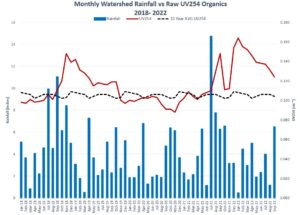
Public notification issued for an exceedance of the maximum contaminant level for HAA5 and TTHM based on sample results from June 2, 2022.
Q2-2022 DBP Status Report:
Though NOM levels have somewhat decreased due to drier weather, NOM levels in the reservoir still remain elevated when compared to the ten year average.
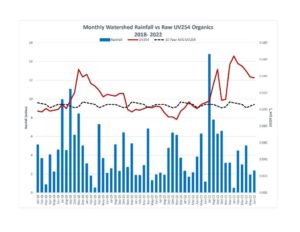
The ability of the Commission to maximize NOM removal has been limited by the ongoing repair of one of the rapid sand filter beds. Due to supply chain disruptions, necessary materials for completing the repair are delayed until later this summer. During summer months with higher water demand, the Commission must rely on older redundant slow sand filters, which are not as effective at removing NOM. This has contributed to the higher levels of DBPs in the distribution system.
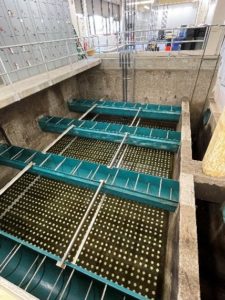
New aeration nozzles are being replaced in a 1970s-era rapid sand filter.
Public notification issued for an exceedance of the maximum contaminant level for HAA5 and TTHM based on sample results from March 3, 2022.
Q1-2022 DBP Status Report:
The higher-than-average rainfall in summer 2021 and annual reservoir turnover that occurred in fall 2021, during which the top layer of water and the bottom of the reservoir mix, resulted in high NOM levels in the raw water. This continued to impact raw water quality into the winter and NOM levels in the reservoir remained unprecedently high.
In January 2022, two of the six rapid sand filter beds (dating from 1974) at West Parish Filters Water Treatment Plant were taken offline to perform emergency repairs. This limited the Commission’s ability to maximize NOM removal while the filters were assessed and/or repaired.
To maintain adequate water production and meet demand the Commission utilized the slow sand filters, in addition to the remaining four rapid sand filter beds. The slow sand filters are less effective at removing NOM than the rapid sand filters, and are typically only used to meet peak (summer) and emergency demand. This, combined with the unprecedently high levels of NOM in the raw water and necessary chlorine dosages to maintain safe disinfection, contributed to elevated HAA5 and TTHM levels in the distribution system.
One of the two rapid sand filter beds was returned to service in March 2022, while the second bed is still undergoing repairs and expected to be operational by July 2022.
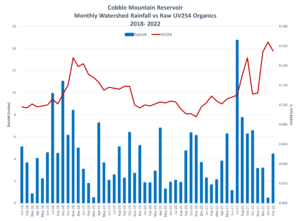
Data shows that high amounts of precipitation are followed by spikes in the amount of natural organic matter (measured by UV254) in Cobble Mountain Reservoir. Following record rainfall in summer 2021, NOM levels remain unprecedently high through February 2022.
2021
Public notification issued for an exceedance of the maximum contaminant level for HAA5 based on sample results from December 2, 2021.
December 2, 2021 Sample Results
Q4-2021 DBP Status Report:
The higher-than-average rainfall in summer 2021, including multiple hurricanes, and annual reservoir turnover that occurred in fall 2021, during which the top layer of water and the bottom of the reservoir mix, resulted in high NOM levels in the raw water.
The high levels of NOM in the raw water and necessary chlorine dosages to maintain safe disinfection contributed to elevated HAA5 levels in the distribution system.
Public notification issued for an exceedance of the maximum contaminant level for HAA5 based on sample results from September 2, 2021.
September 2, 2021 Sample Results
Q3-2021 DBP Status Report:
Higher-than-average rainfall across the region, in July and August 2021, and major weather events including Hurricanes Henri and Ida, resulted in more natural plant matter and soil from the forest floor being washed into Cobble Mountain Reservoir, as well as into the streams and feeder brooks that flow into the reservoir. These rainfall events contributed to an increase in the amount of dissolved NOM in Cobble Mountain Reservoir.
The increase in NOM in the raw water and necessary chlorine dosages contributed to elevated HAA5 levels in the distribution system as sampling was conducted in September 2021.
Results from water quality sampling conducted on June 3, 2021 indicated that DBP levels for HAA5 and TTHM were below regulatory limits at all eight sample locations and public notification was not required.
Q2 – 2021 DBP Status Report:
In summer 2020 the region experienced warm, dry weather with little precipitation. This resulted in less NOM entering the reservoir from rain events, which can transport natural plant matter and soil from the forest into the reservoir. Water quality sample results from June 2021 indicated that dissolved NOM levels in the reservoir had decreased from elevated levels and that the water treatment process had been effective in the reduction of DBPs.
Public notification issued for an exceedance of the maximum contaminant level for HAA5 based on sample results from March 2, 2021.
Q1- 2021 DBP Status Report:
March 2, 2021, sampling indicated that levels for HAA5 at 1 of the 8 sample locations exceeded the MCL.
The MCL for HAA5 is 60 parts per billion (ppb) and is calculated as the average of the results from the past four quarters at an individual sample site. All individual sample-site results from March 2, 2021 were below 60 ppb, however previously elevated quarterly sampling results (from June 2020) were factored into the compliance calculation and the results still qualified as an exceedance.
In early 2021 levels of NOM in the reservoir remained lower than previous high levels experienced in 2018 and 2019, due in part to the warm weather and little precipitation in summer 2020.
Archive of DBP sampling results, 2018-present: https://waterandsewer.org/dbps-faqs/archive-haa5/.